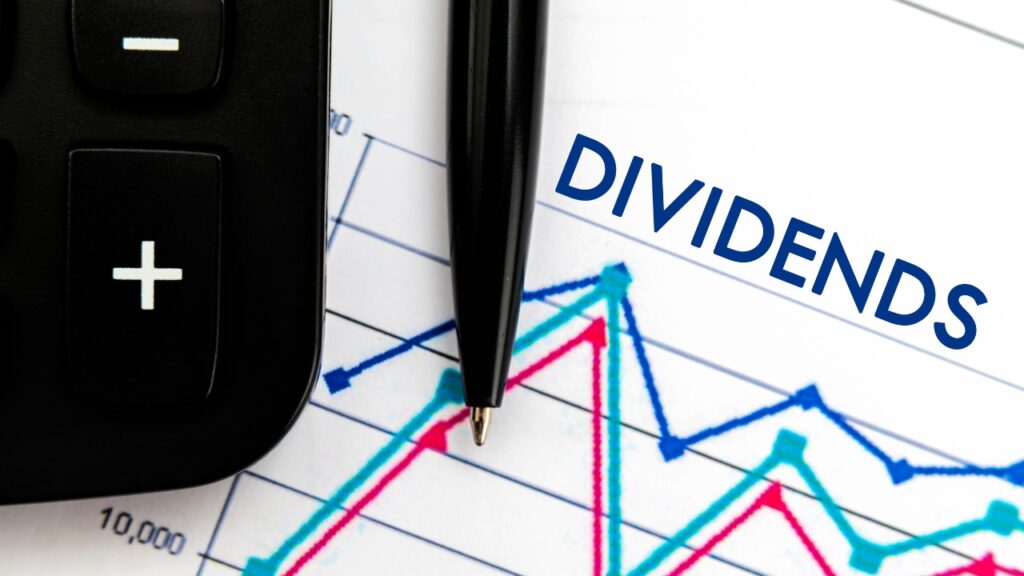Understanding Dividend Stocks
What Are Dividend Stocks?
Dividend stocks are shares in companies that return a portion of their profits to shareholders on a regular basis. These payments—known as dividends—are typically made quarterly but can also be issued monthly or annually depending on the company. Dividend-paying companies are often well-established with a history of profitability and a commitment to sharing earnings with investors.
When you buy a dividend stock, you’re not just hoping the stock price increases—you’re also getting paid to hold it. This dual benefit makes dividend investing especially appealing to those seeking reliable income. Think of it as owning a rental property that pays you rent, but without the hassle of dealing with tenants or maintenance.
Dividends can be paid in cash or additional shares, and they’re usually quoted as a dollar amount per share or as a percentage of the stock price (yield). The beauty of dividend stocks lies in their simplicity: invest capital, collect returns, and potentially grow your income over time.
Why Choose Dividend Investing?
Why should you consider dividend stocks over other investment strategies? One word: consistency. Unlike speculative growth stocks that rely solely on market appreciation, dividend stocks reward you with tangible cash flow even during market downturns.
Dividend investing is especially popular among retirees and those seeking financial independence. It provides a passive income stream that can help cover monthly expenses, supplement social security, or even replace a traditional paycheck.
Moreover, many dividend-paying companies have long track records of increasing their payouts year after year—think Coca-Cola, Johnson & Johnson, or Procter & Gamble. These dividend “aristocrats” often provide both stability and income growth, helping your portfolio beat inflation over time.
Types of Dividend Stocks
Not all dividend stocks are created equal. Here’s a breakdown of the main types:
- Blue-Chip Stocks: These are well-established companies with a reliable history of paying dividends, such as Microsoft or McDonald’s.
- Dividend Growth Stocks: Companies that consistently increase their dividend payouts, often ideal for long-term income growth.
- High-Yield Stocks: These offer higher-than-average dividend returns but may come with increased risk.
- Real Estate Investment Trusts (REITs): Legally required to distribute at least 90% of taxable income to shareholders, making them dividend powerhouses.
- Utility Stocks: Known for stability and consistent dividends due to their essential services.
Each type serves a unique purpose, and diversifying among them can help you build a resilient income portfolio.
Setting Clear Income Goals
Why a $1,000 Monthly Target?
A $1,000 per month goal is a solid benchmark for many aspiring passive income investors. It’s enough to cover rent in some areas, pay off monthly bills, or be reinvested to compound future returns. It’s ambitious yet achievable with a well-structured strategy.
Setting this goal makes the process more concrete. It’s not just about “saving for retirement” anymore—it’s about building a monthly paycheck that gives you freedom. And the good news? You don’t need to be a Wall Street wizard to make it happen.
Calculating Your Needed Investment
So, how much do you need to invest to hit $1,000/month in dividends? Here’s the math:
If your portfolio has an average dividend yield of 4%, you’ll need to invest $300,000 to generate $12,000 annually, or $1,000 per month. Here’s a simple formula:
Investment Needed = Annual Income Goal ÷ Average Dividend Yield
If you find a mix of stocks with an average yield of 6%, your required investment drops to $200,000. That’s why selecting the right mix of stocks matters. But remember—high yield often comes with high risk, so don’t chase numbers blindly.
Monthly vs. Quarterly Dividends
Most U.S. companies pay dividends quarterly, but if your goal is monthly income, you need to plan accordingly. This means choosing a mix of stocks with different payment schedules or focusing on monthly dividend payers like Realty Income (ticker: O) or STAG Industrial.
You can also “ladder” your dividend income—buying different stocks that pay in January, February, March, etc.—to ensure a smooth income stream. This strategy creates a near-monthly income even if the stocks themselves only pay four times a year.
Building a Dividend Investment Strategy
Choosing the Right Dividend Yield
Dividend yield is a crucial metric in building a successful dividend strategy. It represents the percentage return you’ll earn annually from a stock based solely on its dividend payouts. For instance, if a stock priced at $100 pays a $4 annual dividend, its yield is 4%. While high yields may seem tempting, they often signal potential red flags like a struggling company or unsustainable payout.
Instead of chasing the highest yields, focus on sustainable yields—typically between 3% to 5%. These usually come from stable, financially healthy companies with the capacity to maintain or grow dividends over time. It’s a balance between income and safety.
Another key is understanding the payout ratio—the percentage of earnings paid as dividends. A lower payout ratio (e.g., 50% or below) indicates the company has room to reinvest in growth and still cover dividends. High payout ratios (above 80%) might indicate risk, especially if earnings dip.
Dividend Growth vs. High Yield
The debate between dividend growth and high yield is ongoing—and both strategies have merit. High-yield stocks provide more immediate income but often have limited growth potential. They’re ideal for those who want instant cash flow or are in retirement.
On the flip side, dividend growth stocks may start with lower yields but increase payouts consistently over time. This strategy is perfect for long-term investors looking to build wealth and outpace inflation. Think of it like planting a tree: it starts small, but over time it offers plenty of shade.
A blended approach often works best—combine a few high-yield stocks for near-term income with dividend growth stocks that will boost your future cash flow. This way, you get the best of both worlds: steady income today and a growing stream of dividends tomorrow.
Diversification Across Sectors
If you want to rely on dividends as a serious source of income, diversification is essential. No matter how attractive a sector looks—be it real estate, utilities, or healthcare—putting all your eggs in one basket invites unnecessary risk.
A smart dividend investor diversifies across multiple sectors such as:
- Utilities – Known for steady income.
- REITs – Great for high yields and monthly payouts.
- Consumer Staples – Defensive plays with strong dividend histories.
- Healthcare – Often recession-resistant with solid earnings.
- Financials – Banks and insurers that reward shareholders.
Spreading your investments across different industries not only reduces your risk of sector-specific downturns but also helps create a more balanced income stream throughout the year.
Selecting the Right Dividend Stocks
How to Research Dividend Stocks
Picking the right dividend stocks starts with proper research. It’s more than just looking at yield percentages. You need to evaluate the company’s financial health, business model, and dividend sustainability.
Start with these basics:
- Dividend history – Has the company consistently paid or increased dividends for 5+ years?
- Earnings consistency – Are the profits stable or growing over time?
- Cash flow – Are dividends being paid from actual free cash flow?
Also, consider the industry trends. A company may look strong today, but if it’s in a declining industry, future dividends might be in jeopardy. Use financial sites, stock screeners, and annual reports to dig deep into company fundamentals.
Lastly, don’t ignore management. Companies with strong leadership and a shareholder-friendly approach are more likely to keep their dividend promises, even during tough times.
Key Metrics to Analyze
To truly understand a dividend stock’s potential, look beyond just the surface numbers. Here are some key metrics:
- Dividend Yield – The percentage of annual dividends based on current price.
- Payout Ratio – Tells if the dividend is sustainable based on earnings.
- Dividend Growth Rate – How quickly the dividend has increased over the years.
- Free Cash Flow – Reveals if the company generates enough money to cover dividends.
- Debt-to-Equity Ratio – Indicates the financial stability of the company.
Evaluating these metrics helps you avoid dividend traps—companies that offer high yields but are on shaky financial ground. Always compare these values with industry averages for a clearer picture.
Blue-Chip vs. REITs vs. ETFs
When selecting dividend assets, your choice often boils down to three categories:
- Blue-Chip Stocks: Think Johnson & Johnson or Coca-Cola. These are established, reliable dividend payers with decades of consistent returns. They’re the backbone of many portfolios.
- REITs (Real Estate Investment Trusts): These focus on income-producing real estate and offer some of the highest yields available. REITs are legally obligated to pay out 90% of taxable income, making them ideal for income seekers.
- Dividend ETFs: These are exchange-traded funds that hold a basket of dividend stocks. They offer instant diversification and are managed professionally. Top picks include SCHD, VYM, and SPHD.
Each has its strengths. Blue-chip stocks are reliable, REITs provide yield, and ETFs bring diversification. A healthy dividend portfolio often includes a mix of all three.
Creating a Monthly Income Plan
Laddering Dividend Payouts
The key to earning consistent monthly income from dividends lies in payout laddering. Since most stocks pay quarterly, you need to structure your portfolio so that you receive income every month from different sources.
Here’s how:
- Choose companies that pay in different months (e.g., one that pays in Jan/Apr/Jul/Oct, another in Feb/May/Aug/Nov).
- Include monthly payers like Realty Income (O) or Main Street Capital (MAIN) to fill gaps.
By building a payout calendar, you can create a staggered income stream that mimics a monthly paycheck. This strategy doesn’t increase your total income, but it smooths out the cash flow—super helpful for budgeting or reinvestment timing.
Dividend Reinvestment Plans (DRIPs)
DRIPs allow investors to reinvest their cash dividends back into more shares of the company—often commission-free and at a discount. It’s like getting paid and immediately giving yourself a raise.
Here’s why DRIPs are powerful:
- They automate your investment growth.
- Over time, compounding significantly boosts your total returns.
- You gain fractional shares, making every penny of your dividend count.
Even if you’re aiming for $1,000/month, you may choose to reinvest part or all of your dividends initially to grow your portfolio faster. Later, when you’re ready for the income, you can switch off the DRIP and start taking cash payouts.
Tax Considerations for Dividend Income
Taxes can eat into your dividend income if you’re not careful. Here’s a quick breakdown:
- Qualified Dividends (from U.S. companies held long-term) are taxed at 0%, 15%, or 20% depending on your tax bracket.
- Ordinary Dividends (from REITs or foreign stocks) are taxed at your regular income rate.
- Tax-Advantaged Accounts: Holding dividend stocks in IRAs or Roth IRAs can shield you from immediate taxes.
Be mindful of how your portfolio is structured. For maximum efficiency, keep high-yield, non-qualified stocks like REITs in tax-advantaged accounts, and hold qualified dividend payers in your taxable brokerage.
Portfolio Management and Monitoring
Rebalancing Your Portfolio
Rebalancing is one of the most overlooked but vital aspects of maintaining a healthy dividend portfolio. Over time, the value of individual holdings can fluctuate, which can skew your desired asset allocation. For example, if one stock surges while others remain flat, it might start to dominate your portfolio, increasing your exposure to a single company or sector.
To stay on track with your income and risk goals, review and rebalance your portfolio at least once or twice a year. This might involve:
- Selling some overperformers and reallocating funds to underweighted sectors.
- Adding to positions with stronger fundamentals or higher dividend growth potential.
- Reinvesting dividends in a way that maintains your strategic allocation.
Rebalancing ensures you don’t accidentally take on more risk than intended and helps lock in gains from stocks that have appreciated. It’s like tuning up a car—regular check-ups keep everything running smoothly.
Tracking Dividend Payments
Keeping tabs on your dividend income is not just for fun—it’s essential for staying organized and optimizing your cash flow. You should know:
- When each stock pays.
- How much each dividend will be.
- Which stocks are increasing or decreasing their payouts.
Use spreadsheet trackers, apps like DivTracker or Simply Safe Dividends, or your brokerage’s tools. A good tracker will help you visualize trends, identify payment gaps, and evaluate your income reliability.
Tracking also helps identify issues early—like a company quietly cutting its dividend. The earlier you catch it, the quicker you can decide whether to hold, sell, or replace it.
Risk Management in Dividend Investing
Even the most solid dividend stocks aren’t immune to risk. Companies can cut dividends if earnings drop, and market crashes can sink your portfolio’s value. That’s why risk management must be part of your strategy.
Steps you can take:
- Diversify across industries and stock types.
- Limit exposure to high-yield, high-risk stocks.
- Set stop-loss rules to avoid major capital losses.
- Keep a cash cushion or bond allocation for market downturns.
Dividend investing is not “set it and forget it.” Staying vigilant and regularly reviewing your holdings ensures your passive income stays as safe and reliable as possible.
Maximizing Returns With DRIPs and Compounding
How DRIPs Work
Dividend Reinvestment Plans (DRIPs) allow you to automatically reinvest your dividends into more shares of the stock that paid them. This builds wealth over time by growing your share count without additional cash contributions.
Most brokerages offer DRIP features, and some companies have their own DRIP programs that let you buy shares directly—sometimes at a discount. Instead of receiving cash, each dividend payment is used to buy more stock, often in fractional shares.
Over time, this snowballs. The more shares you own, the larger your next dividend payment, which buys more shares—and so on. It’s like earning interest on your interest, but with stocks.
Power of Compounding in Dividend Investing
Compounding is the engine that drives long-term wealth in dividend investing. Even modest dividends can grow significantly when reinvested regularly. Let’s say you invest $100,000 into a portfolio with an average 4% dividend yield, and you reinvest all dividends. Without adding another dollar, your income and capital will both grow steadily.
After 10 years, your $100,000 could grow to over $150,000, with annual dividends climbing from $4,000 to more than $6,000. That’s a 50% income boost without lifting a finger.
Compounding turns good investors into great ones—it rewards consistency and patience. Think of it like planting an orchard: each reinvested dividend is another tree that eventually bears fruit.
Long-Term Growth Potential
The combination of DRIPs and compounding gives dividend investing serious long-term muscle. With a well-diversified portfolio, reinvested dividends, and patience, you can build an income stream that not only keeps pace with inflation but outgrows your financial needs.
Long-term investors benefit from:
- Rising dividend payouts due to growth.
- Share price appreciation.
- A growing income stream that requires no extra effort.
This strategy isn’t about flashy, short-term wins—it’s about reliable, enduring wealth. With the right stocks and a bit of time, that $1,000/month goal becomes not just achievable but potentially expandable.
Avoiding Common Mistakes in Dividend Investing
Chasing High Yields
The most common mistake in dividend investing? Getting lured by sky-high yields. A stock offering a 12% yield might seem like a dream—until it turns into a nightmare. High yields often signal distress, unsustainable payouts, or shrinking share prices.
Companies that promise massive dividends often:
- Operate in risky sectors.
- Have weak earnings.
- Are compensating investors for volatility.
Instead, aim for quality and consistency. A 4% yield from a rock-solid company is far better than a 10% yield that disappears overnight. Always look under the hood before buying a high-yield stock—check payout ratios, earnings trends, and debt levels.
Ignoring Dividend Cuts
Dividend cuts are a warning sign that shouldn’t be ignored. When a company slashes its payout, it usually means deeper financial troubles. Ignoring a cut and holding on out of hope can lead to further capital losses.
To protect yourself:
- Monitor payout ratios and earnings trends.
- Set alerts for dividend announcements.
- Replace problematic stocks quickly with stronger alternatives.
Cutting your losses early often saves more than holding onto hope. Remember, the goal is reliable income, not blind loyalty.
Not Reviewing Financial Health
Too many investors focus on yield alone, ignoring a company’s financial stability. But a dividend is only as good as the company backing it. Review:
- Revenue and earnings growth.
- Free cash flow trends.
- Balance sheet health (especially debt levels).
A company with a strong financial foundation can weather economic storms and continue paying dividends. A weak one? Not so much. Regular reviews ensure your income source stays solid and your portfolio remains on track.
Using Dividend ETFs and Funds
Advantages of Dividend ETFs
Dividend ETFs offer an excellent way to diversify your income sources without picking individual stocks. They provide:
- Instant diversification.
- Professional management.
- Lower risk compared to single stocks.
ETFs like Vanguard High Dividend Yield (VYM) or Schwab U.S. Dividend Equity ETF (SCHD) include dozens or hundreds of dividend-paying companies, which reduces risk and smooths out income. They’re especially great for beginners or those looking for a hands-off investment.
Best Dividend ETFs for Monthly Income
If you’re targeting monthly income, some ETFs are built specifically for that. Examples include:
- Global X SuperDividend ETF (SDIV)
- Invesco Preferred ETF (PGX)
- iShares Preferred and Income Securities ETF (PFF)
These funds often hold REITs, preferred stocks, or international dividend payers that offer monthly payouts. They won’t always match the yield of individual stocks, but the convenience and reliability make them popular for income investors.
Comparing ETFs vs. Individual Stocks
Each has its pros and cons:
| Feature | ETFs | Individual Stocks |
| Diversification | High | Depends on portfolio size |
| Control | Limited (fund decides) | Full control over holdings |
| Dividend Yield | Moderate | Potentially higher |
| Research Requirement | Low | High |
| Income Reliability | Moderate to High | Depends on company performance |
Many investors use a combination—core holdings in ETFs for safety, complemented by handpicked dividend stocks for higher income or growth.
Realistic Timeline to Reach $1,000 Monthly
Timeline Based on Different Investment Amounts
How long it takes to reach $1,000 per month in dividend income depends largely on your starting capital and how aggressively you reinvest and contribute. Here’s a general guideline assuming a 4% yield and reinvested dividends:
- Starting with $10,000: If you contribute $500/month, you might reach your goal in about 20 years.
- Starting with $50,000: Contributing $500/month could cut the timeline to 12–15 years.
- Starting with $100,000: With the same monthly contributions, you might hit your target in under 10 years.
Of course, higher yields or faster contribution growth can shorten this timeline. Using dividend growth stocks that raise their payouts annually will also accelerate progress through compounding.
It’s essential to balance patience with planning. Hitting $1,000/month won’t happen overnight, but consistent investing and reinvestment speed up your path.
Factors That Influence the Timeline
Several variables will either delay or fast-track your goal:
- Dividend Yield: Higher yields provide more income, but be cautious of risks.
- Growth Rate: Companies increasing their dividends annually can double your income over time.
- Reinvestment: Using DRIPs compounds your returns faster.
- Contribution Frequency: Investing monthly—even small amounts—has a massive impact long-term.
- Market Conditions: Bull or bear markets affect growth and reinvestment potential.
Keep a long-term mindset. Dividend investing is a marathon, not a sprint, and staying consistent is more important than chasing short-term gains.
Reinforcing Patience and Consistency
Let’s be honest—dividend investing isn’t exciting. There’s no overnight windfall. But it is effective, sustainable, and powerful when you stick to it. The secret? Patience and consistency.
Even if you start small, consistent monthly investments and reinvesting dividends build momentum. Every dollar works for you. Over time, you’ll see your monthly income creep up—$50, then $100, then $300—and eventually that magic $1,000.
Stay the course. The slow and steady approach isn’t flashy, but it’s a proven path to financial freedom.
Conclusion
Earning $1,000 per month from dividend stocks isn’t just a pipe dream—it’s a tangible goal that many investors have already achieved. With the right combination of planning, strategy, and patience, you can build a portfolio that pays you to do absolutely nothing.
From understanding dividend basics and selecting strong, reliable stocks to managing risks and reinvesting your income, every step matters. Set realistic goals, choose quality over hype, and remember that time and consistency are your best allies.
Whether you’re just starting out with a few hundred dollars or you’re rolling over a six-figure nest egg, the roadmap to $1,000 monthly income is clear. Stay disciplined, track your progress, and watch your dividends do the heavy lifting.
FAQs
That depends on your location and lifestyle. In some areas, it can cover rent or groceries. Many use it to supplement retirement income or build financial independence.
Research companies thoroughly. Focus on those with strong financials, a long history of consistent payouts, and a low payout ratio.
Not necessarily. Monthly stocks offer smoother cash flow, but quarterly payers often have stronger fundamentals. Diversifying across both is smart.
International stocks can diversify your income but may have higher tax implications. Weigh the pros and cons before adding them.
A portfolio with a 3–5% average yield is usually a safe, sustainable starting point. Pair it with dividend growth for long-term success.




